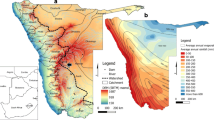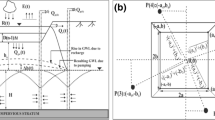Abstract
Recharging from open-surface water resources is investigated as a method for remediation of over-produced and contaminated aquifers. The hydraulic and contaminant modeling using the Modflow-2000 and MT3DMS simulation software are resorted for evaluation of the available options. Methodology is developed and illustrated for reviewing the alternative remediation approaches for optimal selection of the best remediation approach to aquifer recharging from surface waters. The effectiveness of the present systematic approach is demonstrated by identifying the best choice among the multifunctional artificial recharge options available for the Great Forest Park in Debrecen, Hungary.











Similar content being viewed by others
References
Bouwer, H. (2002). Artificial recharge of groundwater: Hydrogeology and engineering. Hydrogeology Journal, 10, 121–142.
Chiang, W. H., & Kinzelbach, W. (2001). 3D-Groundwater modeling with PMWIN. A simulation system for modeling groundwater flow and pollution p. 346. Berlin: Springer.
Dillon, P. (2005). Future management of aquifer recharge. Hydrogeology Journal, 13, 313–316.
Greskowiak, J., Massman, G., Prommer, H., Nützmann, G., & Pekdeger, A. (2005). Geochemical changes under variably saturated conditions during artificial recharge via ponded infiltration—A field study. In G. Nützmann, P. Viotti, & P. Aagaard (Eds.), Reactive transport in soil and groundwater (pp. 51–63). Berlin: Springer.
Harbaugh, A. W., Banta, E. R., Hill, M. C., & McDonald, M. G. (2000). MODFLOW-2000, The U.S. Geological Survey Modular Ground-Water Model—User guide to modularization concepts and the ground water flow process. US Geological Survey, Open-File Report 00-92.
Huysmans, M., Madarasz, T., & Dassargues, A. (2006). Risk Assessment of groundwater pollution using sensitivity analysis and worst case scenario analysis. Environmental Geology, 50(2), 180–193.
Juhasz, J. (2002). Hydrogeology (in Hungarian) pp. 1–1176. Budapest: Academy Publisher.
Kalf, F. R. P., & Woolley, D. R. (2005). Applicability and methodology of determining sustainable yield in groundwater systems. Hydrogeology Journal, 13, 295–312.
K+K Austrian–Hungarian Environmental Management Plc (2004). Multifunctional artificial groundwater recharge for the Great-Forest in Debrecen. Detailed summary report, pp. 1–65.
Konikow, L. F., & Kendy, E. (2005). Groundwater depletion: A global problem. Hydrogeology Journal, 13, 317–320.
McDonald, M. G., & Harbaugh, A. W. (2003). The History of MODFLOW. Ground Water, 41(2), 280–283.
Marton, L., & Szanyi, J. (2000). The connection between the shallow groundwater level and the groundwater protection in the region of Debrecen (in Hungarian). Hydrology Bulletin in Hungary, 80, 3–13.
Szanyi, J. (2004). The environmental effects of groundwater production using a case-study example in the South-Nyirseg. Ph.D. dissertation, University of Szeged, Hungary, pp. 1–88.
Szekely, F. (1990). Drawdown around a well in a heterogeneous, leaky aquifer system. Journal of Hydrology, 118, 247–256.
Szucs, P., Civan, F., & Virag, M. (2006). Applicability of the most frequent value method in groundwater modeling. Hydrogeology Journal, 14, 31–43.
Szucs, P., & Ritter, G. Y. (2002). Improved interpretation of pumping test results using simulated annealing optimization. ModelCARE 2002. Proceedings of the 4th International Conference on Calibration and Reliability in Groundwater Modeling. Prague, Czech Republic, 17–20 June 2002. Acta Universitas Carolinae—Geologica, 46(2/3), 238–241.
Toth, J. (1995). Hydraulic continuity in large sedimentary basins. Hydrogeology Journal, 3(4), 4–16.
Zheng, C., & Wang, P. (1999). MT3DMS: Modular three-dimensional multispecies transport model for simulation of advection, dispersion and chemical reactions of contaminants in groundwater systems. documentation and user’s guide. US Army Corps of Engineers, Contract Report SERDP-99-1, pp. 1–169.
Acknowledgment
The authors of this paper wish to thank the National Scientific and Research Fund (contract no: OTKA 048329), the GVOP programs (GVOP-3.1.1.-2004-05-0187/3.0 and GVOP-3.1.1.-2004-05-0530/3.0), and the Bolyai János Research Scholarship for the support in implementing the study presented in this paper.
Author information
Authors and Affiliations
Corresponding author
Appendix
Appendix
1.1 Description of the Software Used for Model Construction
The studies mentioned in the main text have facilitated several ready-made computer codes as described in the following.
Modflow is a US Geological Survey (USGS) modular finite-difference flow model. This computer code can solve the groundwater flow equation. The governing partial differential equation solved numerically in Modflow is given in the following form:
where K xx, K yy, and K zz are the values of the hydraulic conductivity along the x, y, and z coordinate axes (L/T); h is the hydraulic head (L); W is the volumetric flux per unit volume representing the sources and sinks of groundwater; for which the negative values denote extractions, while the positive values denote injections (T −1); SS is the specific storage of the investigated aquifer (L −1); and t is time (T). This program is widely used throughout the world by hydrogeologists to simulate the flow of groundwater through aquifers. The code is free software, written in the Fortran language and can be compiled and run on the DOS, Windows, or UNIX operating systems. Since its original development in the early 1980s [11], the USGS have released four major versions of this code and is now considered to be the de facto standard industrial code among the groundwater specialists for aquifer simulation. Currently, there are many actively developed commercial and non-commercial graphical user interfaces for Modflow.
The Modflow-2000 version was released on July 20, 2000. Many new packages and enhancements were also released, including new solvers, and stream and saturated flow packages. The following packages of Modflow-2000 were used to describe the different source and sink terms during the above-mentioned simulation activity of the present studies: General-Head Boundary (GHB), Drain, Evapotranspiration, Reservoir, Lake, and Well and Recharge.
There are several graphical interfaces to Modflow, which often include the compiled Modflow code. These programs provide convenient means of supplying the input data for creating Modflow models. Commercial Modflow programs are typically used by governments and consultants for practical applications of Modflow to real-world groundwater problems. The applied PMWIN-Pro may be considered as a professional commercial version of Modflow.
A three-dimensional flow model considering three-layers was implemented with the help of the Modflow-2000 module in the present study. This model was used to characterize the main hydrostratigraphic units of the investigated area, namely the lower Pleistocene “waterworks” aquifer, the middle Pleistocene aquifer, and the unconfined upper aquifer that also contains a shallow groundwater aquifer. The input data required for the flow model was readily available from an earlier geological and hydrogeological prospecting activity. A regional flow model [13] was also available to delineate the well-head protection zones around the water-works wells in the Great Forest. In addition to the results of the laboratory and pumping tests, the data provided in Table 1 was also imported from this regional flow model into the final flow model for simulation of the various artificial recharge options.
The flow model was first calibrated to the measured groundwater level data before the simulation of the various artificial recharge options. The GHB hydraulic conductance and the value of the natural recharge (as model parameters) were determined during the calibration process. The root-mean-square error value concerning the calibration was 0.14 m. As the hydraulic head of the investigated aquifer is around 120 m, the actual error concerning the calculated groundwater levels is slightly more than 0.1%. This means that the calibrated flow model describes the real groundwater flow system quite accurately. Therefore, the calibrated well-working flow model could be used to simulate successfully the different artificial recharge scenarios and their effects in space and time as described in detail in the main text.
Besides the flow model, a transport model was also built to investigate the several groundwater quality issues. The transport movement investigations were carried out in the field-study by the help of the MT3DMS model [18], where MT3D stands for the modular 3-dimensional transport model, and MS denotes the multi-species structure for accommodating add-on reaction packages. MT3DMS has a comprehensive set of options and capabilities for simulating the advection, dispersion, diffusion, and chemical reactions of contaminants in groundwater flow systems under the general hydrogeologic conditions. The MT3DMS was developed for use with any finite-difference flow model such as Modflow and is based on the assumption that changes in the concentration field will not affect the flow field appreciably.
The partial differential equation describing the fate and transport of contaminants of the species k in a 3D space in transient groundwater flow systems can be written as follows:
where ϕ denotes porosity of the aquifer, dimensionless (fraction); C k is the dissolved concentration of species k, (M/L3); t is time (T); x i,j is distance along the respective Cartesian coordinate axis (L); D i,j is the hydrodynamic dispersion coefficient tensor (L 2/T); v i is the seepage or linear pore water velocity based on the Darcy equation (L/T); q s is the volumetric flow rate per unit volume of aquifer representing fluid sources and sinks(1/T);\(C_s^k \) is the concentration of the source or sink flux for species k (M/L 3); and \(\sum {R_n } \) is the chemical reaction term (M/L 3/T).
The complex hydrocarbon (total petroleum hydrocarbon) contamination problem mentioned in the main text was investigated by the transport modeling. The maximum concentration of the contamination plume is 3,000 μg/l. The required transport parameters of the investigated contamination and the aquifer were derived from the literature and laboratory measurements.
The CIVAQUA project was introduced originally by the city of Debrecen to mitigate and solve the different water management problems (like irrigation, artificial recharge, water purification, wetland rehabilitation, etc.) in the region. Now, the CIVAQUA program is led and organized by the Hungarian Trans-Tisza Region Environmental and Water Authority in Debrecen. One of the key issues of the program is to provide the multifunctional artificial recharge of the Great Forest in Debrecen. The further details can be found on the homepage of the CIVAQUA project (http://www.civaqua.hu).
Rights and permissions
About this article
Cite this article
Szucs, P., Madarasz, T. & Civan, F. Remediating Over-Produced and Contaminated Aquifers by Artificial Recharge from Surface Waters. Environ Model Assess 14, 511–520 (2009). https://doi.org/10.1007/s10666-008-9156-4
Received:
Accepted:
Published:
Issue Date:
DOI: https://doi.org/10.1007/s10666-008-9156-4




